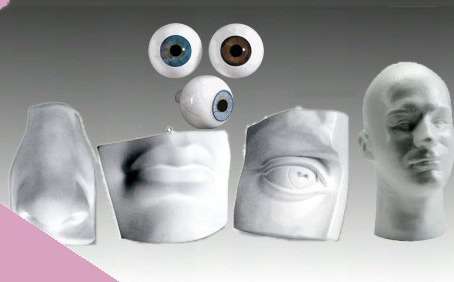A variety of mold making and life casting kits are featured on the EnvironMolds website. This serves as a quick and easy introduction to these specialized arts. The options are varied and interesting.
EnvironMolds offers an extensive range of mold making, casting and lifecasting kits that are especially handy for beginners. The kits contain all the required materials, supplies and tools for a one-time project.
For instance, the Latex EZ Casting kit has everything needed to create molds of a Trilobite fossil and a life-sized snail followed by a casting. Accordingly, it contains Kreemtex Liquid Premium Mold Making Rubber, CastRite Art Stone, Chavaunt clay, fossils, mixing cups, mixing sticks, brushes, cotton swab and fine cheesecloth. The materials are of studio quality; the quantity and size are suitable for the project on hand. It also comes with an illustrated instruction guide that demonstrates each and every step with full clarity and detail. The directions are easy to follow and the process becomes interesting and enjoyable.
The life casting kits are a complete delight as well. In fact, the company website http://www.artmolds.com features the largest collection of life casting kits available anywhere. There are various kit options for casting a baby's hand and foot, adult hands, faces, torso and even the full body. They are helpfully marked as beginner, experienced and advanced levels.
EnvironMolds offers an extensive range of mold making, casting and lifecasting kits that are especially handy for beginners. The kits contain all the required materials, supplies and tools for a one-time project.
For instance, the Latex EZ Casting kit has everything needed to create molds of a Trilobite fossil and a life-sized snail followed by a casting. Accordingly, it contains Kreemtex Liquid Premium Mold Making Rubber, CastRite Art Stone, Chavaunt clay, fossils, mixing cups, mixing sticks, brushes, cotton swab and fine cheesecloth. The materials are of studio quality; the quantity and size are suitable for the project on hand. It also comes with an illustrated instruction guide that demonstrates each and every step with full clarity and detail. The directions are easy to follow and the process becomes interesting and enjoyable.
The life casting kits are a complete delight as well. In fact, the company website http://www.artmolds.com features the largest collection of life casting kits available anywhere. There are various kit options for casting a baby's hand and foot, adult hands, faces, torso and even the full body. They are helpfully marked as beginner, experienced and advanced levels.
For instance, the Pro Hand EZ Cast Kit is perfectly suitable for serious life casters who want to turn this artistic hobby into a part-time business. This bestseller has actually been tested and approved by 60 members of the reputed Home Arts Magazine Club. Yet, even novices can use the kit to create museum-quality sculptures. It is also used by professionals to create hand castings for profit at various venues.
The beauty of the kits is that the user does not have to assemble all the nitty-gritty materials for making a mold, cast or life cast. The quantities are appropriate, thus eliminating guesswork while purchasing individual projects. Moreover, the user will also get an idea about what and how much to buy when working on similar projects in the future.
The beauty of the kits is that the user does not have to assemble all the nitty-gritty materials for making a mold, cast or life cast. The quantities are appropriate, thus eliminating guesswork while purchasing individual projects. Moreover, the user will also get an idea about what and how much to buy when working on similar projects in the future.
0 Comments











